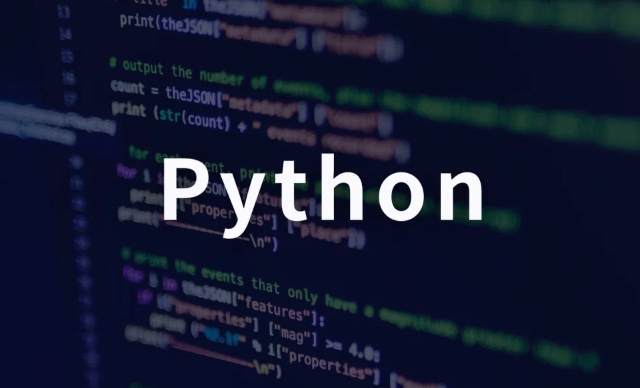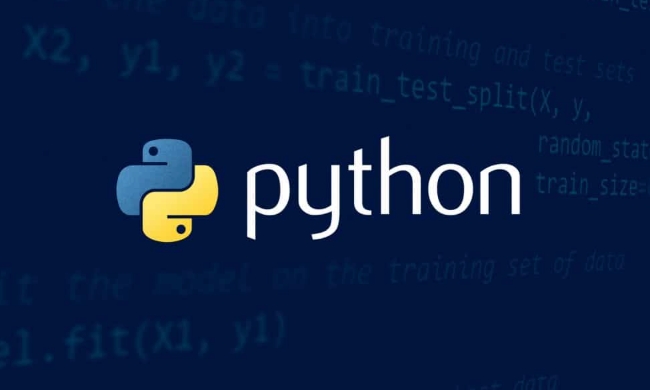Python is a flexible tool for processing metadata, suitable for automated extraction, modification, or management of file metadata. 1. Use the os and pathlib modules to obtain basic file information such as size and modification time; 2. The Pillow and exif libraries can be used to read image EXIF data such as camera model and shooting time; 3. PyPDF2 or pypdf can be used to manage PDF author, title and other metadata; 4. Note that some files may lack complete metadata, and some libraries only support specific formats. Unnecessary information should be cleaned when processing sensitive data, and a virtual environment should be used to avoid dependency conflicts.

Python is a very flexible tool for processing metadata, especially suitable for scenarios where file metadata needs to be extracted, modified, or managed automatically. Whether it is pictures, documents, or audio and video files, Python can easily handle it through third-party libraries.

Extract basic metadata of files
Many common file formats contain basic metadata, such as creation time, modification time, size, etc. Python's os and pathlib modules can easily obtain this information.
Taking pathlib as an example, you can do this by getting the basic information of a file:

from pathlib import Path
file = Path("example.jpg")
print(f"File name: {file.name}")
print(f"Size: {file.stat().st_size} bytes")
print(f"Last modified time: {file.stat().st_mtime}")This approach works for any type of file and does not require additional dependencies to be installed. Although detailed metadata related to the content of the file cannot be read (such as the photo shooting device), it is useful as a preliminary filtering or sorting of files.
Processing EXIF data for pictures
If you want to process detailed metadata of the picture, such as viewing the camera model, shooting time, GPS location, etc., you need to use a library that specifically analyzes EXIFs. Commonly used are Pillow and exif .

Use the exif library to view the details of the photo:
from exif import Image
with open("photo.jpg", "rb") as image_file:
img = Image(image_file)
print(img.has_exif) # determine whether there is EXIF data print(img.model) # Camera model print(img.datetime) # Shooting timeNote: Some image editing software will clear EXIF data, so it is best to confirm whether it is still retained before processing. If you want to batch clean or modify EXIF, you can also write a script to handle it in a unified manner using a similar method.
Manage metadata for documents and PDFs
PDF files usually also contain metadata such as author, title, keyword, etc. You can use PyPDF2 or newer pypdf to read and set this information.
For example, view the metadata of a PDF:
from pypdf import PdfReader
reader = PdfReader("document.pdf")
info = reader.metadata
print(info.title)
print(info.author)If you want to automatically add company name, project number and other information when generating reports or exporting files, you can also set these fields dynamically with code.
Don't ignore small details
- Not all files have complete metadata, especially those that have been compressed or converted.
- Some libraries only support specific formats, such as
exifonly works for JPEG images. - If you are dealing with privacy-sensitive data, remember to delete unnecessary metadata and then publish the file.
- Use a virtual environment to isolate dependencies from different projects and avoid version conflicts.
Basically that's it. Although Python is not the only option in metadata management, combining rich libraries and concise syntax is indeed a very practical solution.
The above is the detailed content of Metadata Management with Python. For more information, please follow other related articles on the PHP Chinese website!

Hot AI Tools

Undress AI Tool
Undress images for free

Undresser.AI Undress
AI-powered app for creating realistic nude photos

AI Clothes Remover
Online AI tool for removing clothes from photos.

Clothoff.io
AI clothes remover

Video Face Swap
Swap faces in any video effortlessly with our completely free AI face swap tool!

Hot Article

Hot Tools

Notepad++7.3.1
Easy-to-use and free code editor

SublimeText3 Chinese version
Chinese version, very easy to use

Zend Studio 13.0.1
Powerful PHP integrated development environment

Dreamweaver CS6
Visual web development tools

SublimeText3 Mac version
God-level code editing software (SublimeText3)
 Polymorphism in python classes
Jul 05, 2025 am 02:58 AM
Polymorphism in python classes
Jul 05, 2025 am 02:58 AM
Polymorphism is a core concept in Python object-oriented programming, referring to "one interface, multiple implementations", allowing for unified processing of different types of objects. 1. Polymorphism is implemented through method rewriting. Subclasses can redefine parent class methods. For example, the spoke() method of Animal class has different implementations in Dog and Cat subclasses. 2. The practical uses of polymorphism include simplifying the code structure and enhancing scalability, such as calling the draw() method uniformly in the graphical drawing program, or handling the common behavior of different characters in game development. 3. Python implementation polymorphism needs to satisfy: the parent class defines a method, and the child class overrides the method, but does not require inheritance of the same parent class. As long as the object implements the same method, this is called the "duck type". 4. Things to note include the maintenance
 Explain Python generators and iterators.
Jul 05, 2025 am 02:55 AM
Explain Python generators and iterators.
Jul 05, 2025 am 02:55 AM
Iterators are objects that implement __iter__() and __next__() methods. The generator is a simplified version of iterators, which automatically implement these methods through the yield keyword. 1. The iterator returns an element every time he calls next() and throws a StopIteration exception when there are no more elements. 2. The generator uses function definition to generate data on demand, saving memory and supporting infinite sequences. 3. Use iterators when processing existing sets, use a generator when dynamically generating big data or lazy evaluation, such as loading line by line when reading large files. Note: Iterable objects such as lists are not iterators. They need to be recreated after the iterator reaches its end, and the generator can only traverse it once.
 How to handle API authentication in Python
Jul 13, 2025 am 02:22 AM
How to handle API authentication in Python
Jul 13, 2025 am 02:22 AM
The key to dealing with API authentication is to understand and use the authentication method correctly. 1. APIKey is the simplest authentication method, usually placed in the request header or URL parameters; 2. BasicAuth uses username and password for Base64 encoding transmission, which is suitable for internal systems; 3. OAuth2 needs to obtain the token first through client_id and client_secret, and then bring the BearerToken in the request header; 4. In order to deal with the token expiration, the token management class can be encapsulated and automatically refreshed the token; in short, selecting the appropriate method according to the document and safely storing the key information is the key.
 Explain Python assertions.
Jul 07, 2025 am 12:14 AM
Explain Python assertions.
Jul 07, 2025 am 12:14 AM
Assert is an assertion tool used in Python for debugging, and throws an AssertionError when the condition is not met. Its syntax is assert condition plus optional error information, which is suitable for internal logic verification such as parameter checking, status confirmation, etc., but cannot be used for security or user input checking, and should be used in conjunction with clear prompt information. It is only available for auxiliary debugging in the development stage rather than substituting exception handling.
 How to iterate over two lists at once Python
Jul 09, 2025 am 01:13 AM
How to iterate over two lists at once Python
Jul 09, 2025 am 01:13 AM
A common method to traverse two lists simultaneously in Python is to use the zip() function, which will pair multiple lists in order and be the shortest; if the list length is inconsistent, you can use itertools.zip_longest() to be the longest and fill in the missing values; combined with enumerate(), you can get the index at the same time. 1.zip() is concise and practical, suitable for paired data iteration; 2.zip_longest() can fill in the default value when dealing with inconsistent lengths; 3.enumerate(zip()) can obtain indexes during traversal, meeting the needs of a variety of complex scenarios.
 What are python iterators?
Jul 08, 2025 am 02:56 AM
What are python iterators?
Jul 08, 2025 am 02:56 AM
InPython,iteratorsareobjectsthatallowloopingthroughcollectionsbyimplementing__iter__()and__next__().1)Iteratorsworkviatheiteratorprotocol,using__iter__()toreturntheiteratorand__next__()toretrievethenextitemuntilStopIterationisraised.2)Aniterable(like
 What are Python type hints?
Jul 07, 2025 am 02:55 AM
What are Python type hints?
Jul 07, 2025 am 02:55 AM
TypehintsinPythonsolvetheproblemofambiguityandpotentialbugsindynamicallytypedcodebyallowingdeveloperstospecifyexpectedtypes.Theyenhancereadability,enableearlybugdetection,andimprovetoolingsupport.Typehintsareaddedusingacolon(:)forvariablesandparamete
 Python FastAPI tutorial
Jul 12, 2025 am 02:42 AM
Python FastAPI tutorial
Jul 12, 2025 am 02:42 AM
To create modern and efficient APIs using Python, FastAPI is recommended; it is based on standard Python type prompts and can automatically generate documents, with excellent performance. After installing FastAPI and ASGI server uvicorn, you can write interface code. By defining routes, writing processing functions, and returning data, APIs can be quickly built. FastAPI supports a variety of HTTP methods and provides automatically generated SwaggerUI and ReDoc documentation systems. URL parameters can be captured through path definition, while query parameters can be implemented by setting default values ??for function parameters. The rational use of Pydantic models can help improve development efficiency and accuracy.






